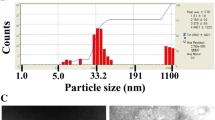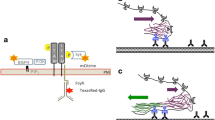Abstract
Previously, we constructed DNA vectors containing cDNAof Mac-1 subunits (CD11b or CD18b) fused with fluorescence protein (FP). cDNA fragments and the DNA constructs were then transfected into CHO cells (as CHO-Mac-1-FP). The structure and function of Mac-1-FP obtained from the CHO-Mac-1-FP cells are nearly identical to that expressed in wild type leukocytes. In the present study, the intracellular trafficking of Mac-1 was visualized directly by monitoring the fluorescent intensities of YFP-CD18 and PE-conjugated monoclonal antibody against CD11b under a confocal microscope in CHO-Mac-1-FP cells. The results indicate that: (i) although Mac-1 was not detected in the cell membrane at resting state, it had been translocated and clustered into the cell membrane by 1 h and internalized 2 h after PMA stimulation, at which point the fluorescence intensity began to diminish gradually, probably due to partial degradation of Mac-1. The fluorescence of CD18 and CD11b reappeared on the cell membrane 1 h after re-treatment with PMA, suggesting the recycling of non-degraded Mac-1. (ii) The adhesion rate of CHO-Mac-1-FP to magnetic beads coupled ICAM-1 increased within 4 h after their initial interaction, accompanied by the clustering of Mac-1-FP. After 8 h, the adhesion rate declined and fluorescence also decreased simultaneously. The pattern of change in fluorescence in CHO-Mac-1-FP cells elicited by ICAM-1 beads was similar to that elicited by PMA, suggesting that endocytosis and degradation of Mac-1 occurred after the interaction with ICAM-1. Thus, we conclude that the intracellular trafficking of Mac-1 after activation is associated with membrane translocation, endocytosis, degradation and recycling. These changes are in parallel with the adhesion of CHO-Mac-1-FP cells with ICAM-1, and may be involved in the adhesion and detachment of leukocytes. The detachment of leukocytes may be caused by endocytosis of Mac-1.
Similar content being viewed by others
References
Davenpeck, K. L., Zagorski, J., Schleimer, R. P. et al., LPS-induced leukocyte rolling and adhesion in the rat mesenteric microcirculation by glucocorticoids and role of cytokine, J. Immunol., 1998, 161(12): 6861–6870.
McDowall, A., Leitinger, B., Stanley, P. et al., The I-domain of integrin leukocyte function-associated antigen-1 is involved in a conformational change leading to high affinity binding to ligand intercellular adhesion molecule 1 (ICAM-1), J. Biol. Chem., 1998, 273(17): 10556–10566.
Simms, H. H., D’Amico, R., LPS induces intracytoplasmic migration of the polymorphonuclear leukocyte CD 11b/CD 18 receptor, Shock, 1995, 3(3): 196–203.
Stein, C. A., Controversies in the cellular pharmacology of oligodeoxynucleotides, Ciba-Found-Symp, 1997, 209: 79–89; 89–93.
Garcia, V. R., Diaz-Gonzalez, F., Gonzalez, A. I. et al., Prevention of cytokine-induced changes in leukocyte adhesion receptors by nonsteroidal antiinflammatory drugs from the oxicam family, Arthritis-Rheum, 1997, 40(1): 143–153.
Yan Ming, Mao Jifang, Yang Shengsheng et al., Construction of Mac-1-FP expression vector, expression of Mac-1-FP and its characterization, Chin. J. Biochem. Mol. Biol., 2003, 19(6): 763–768.
Chen, H. M., Pahl, H. L., Scheibe, R. J. et al., The SP-1 transcription factor binds the CD 11b promoter specifically in myeloid cell in vivo and is essential for myeloid-specific promoter activity, J. Biol. Chem., 1993, 268(11): 8230–8239.
Williams, M. A., Solomkin, J. S., Integrin-mediated signaling in human neutrophil functioning, J. Leuk. Biol., 1999, 65(6): 725–736.
Weber, S., Babina, M., Feller, G. et al., Human leukaemic (HMC-1) and normal skin mast cells express beta 2-integrins: Characterization of beta 2-integrins and ICAM-1 on HMC-1 cells, Scand.-J.-Immunol., 1997, 45(5): 471–481.
Wright, S. D., Meyer, B. C., Phorbol esters cause sequential activation and deactivation of complement receptors on polymorphonuclear leukocytes, J. Immunol., 1986, 136: 1759–1764.
Chambers, J. D., Simon, S. I., Berger, E. M. et al., Endocytosis of β 2 integrins by stimulated human neutrophils analyzed by flow cytometry, J. Leuk. Biol., 1993, 53: 462–469.
Davey, P. C., Zuzel, M., Kamiguti, A. S. et al., Activation-dependent propeolytic degradation of polymorphonuclear CD11b, Brit. J. Haemat., 2000, 111: 934–942.
Evangelista, V., Manarini, S., Rotondo, S. et al., Platelet/polymorphonuclear leukocyte interaction in dynamic conditions: evidence of adhesion cascade and cross talk between P-selectin and the beta 2 integrin CD11b/CD18, Blood, 1996, 88(11): 4183–4194.
Brotscher, M. S., Endocytosis and recycling of fibronectin receptor in CHO cells, EMBO J., 1989, 8: 1341–1348.
Brotscher, M. S., Circulating integrins: Alpha 5 beta1, alpha 6 beta 4 and Mac-1, but not alpha3 beta 1, alpha 4 beta 1 or LFA-1, EMBO J., 1992, 11: 405–410.
Author information
Authors and Affiliations
Corresponding author
Rights and permissions
About this article
Cite this article
Yan, M., Mao, J., Wei, Y. et al. Study on intracellular trafficking of Mac-1 by direct visualization. Sci. China Ser. C.-Life Sci. 47, 521–529 (2004). https://doi.org/10.1360/02yc0232
Received:
Revised:
Issue Date:
DOI: https://doi.org/10.1360/02yc0232




